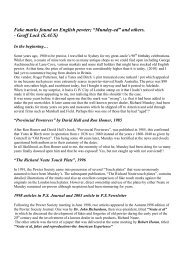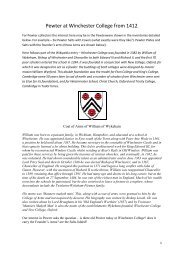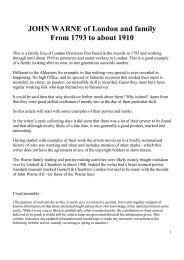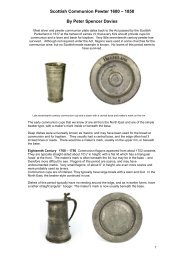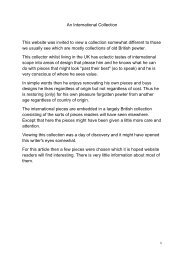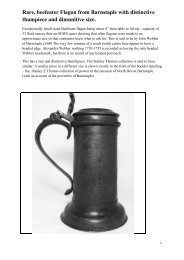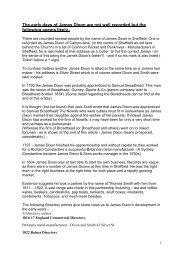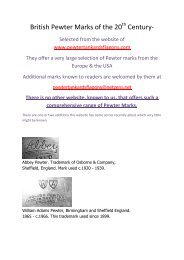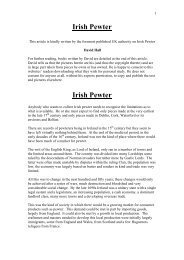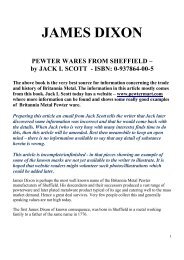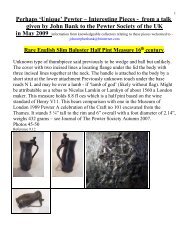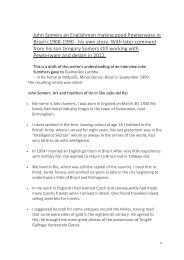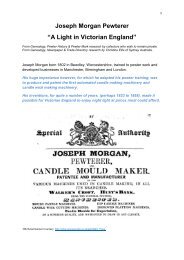FOTHERGILL OF BRISTOL (date) AND A VERY ... - PewterBank
FOTHERGILL OF BRISTOL (date) AND A VERY ... - PewterBank
FOTHERGILL OF BRISTOL (date) AND A VERY ... - PewterBank
Create successful ePaper yourself
Turn your PDF publications into a flip-book with our unique Google optimized e-Paper software.
<strong>FOTHERGILL</strong> <strong>OF</strong> <strong>BRISTOL</strong><br />
(1718-1845)<br />
A <strong>VERY</strong> DISTINCTIVE (UNIQUE) SHAPE<br />
<strong>OF</strong> MEASURE<br />
Named Fothergill, Bristol pewterers, the little history as is available to this<br />
writer in April 2010.<br />
William Best Fothergill worked from 1718 – 1745 in Bristol and is mentioned as a customer of John<br />
Duncumb of Bewdley, so it is unknown if he was actually a pewterer or if he simply sold pewter wares.
Mark Fothergill son of William Best Fothergill worked from 1752 – 1800, he had been apprenticed to a<br />
Benjamin Collier and his wife Elizabeth in 1745 (so likely born late 1720s). The <strong>date</strong> of his fathers death<br />
being the same year as he started his apprenticeship does not help us to understand how his father<br />
worked. Mark is also unlikely then to have been very active when M Fothergill & Sons was formed (trading<br />
perhaps 1793 – 1845).<br />
M Fothergill & Sons was a working pewtering business from around 1793 to 1835. There were three<br />
partners. Mark Fothergill, William Fothergill and Arabella Fothergill. Although this trading business was<br />
dissolved in 1805 it likely continued after 1826 as there are imperial measures found. But the partners may<br />
have changed after that <strong>date</strong>.<br />
William Fothergill working 1793-1819 in Redcliff Street Bristol was a partner in the above business. The<br />
relationship with Arabella is not understood by this writer.<br />
Henry Fothergill worked from 1819 to about 1845 mentioned in trade directories in 1845 and before in 1840<br />
he may have been a partner with William before 1819<br />
(A John Fothergill with no known connection worked in Newcastle on Tyne in about 1653)<br />
Matching pair of quart & pint by Mark Fothergill & Sons Bristol c1793-1835 (OP1740) their circular<br />
mark under base. All conical measures are rare, and a matching pair is almost impossible to<br />
find. These are Tall ovoid body form with tongued thumbrest ball terminal handle. They are Verified in<br />
the mouth with early City of Bristol verifications: crown over BC (struck through) and crown over BC<br />
over E. Usually marked IMPERIAL under lip. These are in superb condition, and with medium-dark grey<br />
original surface patina. The ovoid shape meant the easiest way to finish these measures was by hand<br />
scraping, and feint traces of the vertical scrape marks remain on the bodies and handles. 7⅛" & 6⅛"<br />
overall heights, and 4Å" & 3Å" base diameters.
Now here is the NUB of the question did the Fothergills make this very<br />
idiosyncratic style (almost impossible to clean out!) in any other size –<br />
are any of the others shown actually theirs(actually made by them!)<br />
Is this indeed, in the above style - unique to the Fothergills of Bristol!<br />
This design is the very reason for their inclusion on this website, it was not<br />
copied (until the 1920s) that the writer knows of.<br />
There will be a book shortly it is understood concerning these pewterers but this<br />
website has been unable to obtain confirmation or otherwise regarding the<br />
information offered here!
Is this a Fothergill A mystery<br />
To quote the owner today - It is a half-gallon bought years ago when the contents of Barrington Hall, near IIminster<br />
Somerset were sold. It came from the collection of Col Lyle who restored Barrington as the first National Trust lessee.<br />
He was the Lyle in Tate & Lyle sugar. Perhaps it might be an Exeter piece with the double scroll handle and other<br />
unusual features. It is verified for Somerset, and has a unique cross of two pewter straps under the base, which you<br />
might assume was to add extra strength although it is a massively cast piece.<br />
The neck looks more like the Australian pieces and they are more likely made by Gaskell & Chambers<br />
towards the very end of the 1800s but surely this appears older<br />
Exceptional Pewter Pint mug by Mark Fothergill & Sons,<br />
Bristol c1825 (OP 1740)<br />
For a very brief period, these were made using 18 th century ball terminal handle moulds. The very unusual<br />
body is not ‘extended’, as the lip and body are cast in one piece. Quart and half-pint examples are also<br />
known, but all are very rare. Struck with the maker’s mark only very faintly remaining in the base, and their<br />
distinctive ‘IMPERIAL’ label to the left of the handle. This is verified twice for the City of Bristol. . 5⅜”<br />
high. Rim diameter 3 Ö”Footrim diameter just under 3 Ö” Weight about 14 ozs.<br />
Reference MKOY-016 – 387 Photos 244 - 252 Collection
Although unmarked, this is guaranteed to be a Bristol made<br />
piece from the body shape, and distinctive form of ball terminal<br />
handle. Most likely, this is a Fothergill conical measure, and is<br />
a half-gallon, which is one of the rarest sizes. Indeed, only one<br />
other of this form is known. Well struck capacity mark ‘Å<br />
GALLON’ below the rim. Verified for ‘D’ Division of<br />
Southampton County. Nice turning lines under the base. In<br />
exceptional condition, with attractive medium-grey original<br />
surface patina. 9” high, with 3⅝” mouth & 6” base diameters.<br />
Images/photos provided by www.pewtersellers.com
Something near<br />
Very rare pre-Imperial Å-pint (Old English Wine Standard) conical measure by<br />
Edgar, Curtis & Co Bristol c1793-1801 (OP1266a/1508) their circular mark with<br />
an X struck under the base. This measure is in 'as found' condition. It is<br />
undamaged but has a very poor surface, which is uneven through flaking<br />
oxide. 4Å" overall height, 3" base diameter.
The following shows Various 19 th century styles of similar known measures but<br />
none have that elegance and difficulty that expresses itself so well in the<br />
uniqueness of the <strong>FOTHERGILL</strong> measure.<br />
IRISH HARVESTER MEASURES <strong>OF</strong> THE 1800S.
A rare set of West Country Style Pewter Measures<br />
A scarce even rare set of West Country style measures but actually made in Birmingham. Sizes gill to quart.<br />
All have Birmingham verification marks, two smaller one VR over 6 and the two larger ones VR over a<br />
shield. Appears to be a very rare original set. No repairs known of. All bearing the size (Quart, Pint, Ö Pint,<br />
Quartern) to the left of the handle. Cleaned pewter patina. A few small grazes but remarkable condition,<br />
considering long usage. Dimensions as follows Quart – 2 lbs 1 oz Height 6” footrim 5 Ö” Pint – 1 lb 3 Ö ozs<br />
Height 5 Ö” footrim 4 Ö” Ö Pint – 13 ozs Height 41/4” footrim 3 Ü” Quartern – over 7 ozs Height 3 Ö”<br />
footrim 3”<br />
An Exceptional Pair of Pewter Conical West Country Measures with State of Victoria Australia<br />
Verification (late 1800s )<br />
The wonderful shape of this very rare pair of measures and their delightful pewter patina and their rarity<br />
makes them exceptional. The larger is probably half pint and the smaller the gill size. Although West<br />
Country is the style many of these were made in the Midlands and in Victorian times although it is clear an<br />
unknown artisan made these to a very high standard and design of his own. The verification visible on both<br />
just to the right of the hollow handle is unusually for the State of Victoria in Australia. And there are no other<br />
marks.The half pint size weighs over 1lb 2 ozs stands about 4” with a footrim over 4 á” and has nice turning<br />
marks to the underbase. The foot is also heavy and strong.<br />
The gill size weighs over 10 ozs and stands over 3” tall with a footrim about 3 Ö” diameter.



